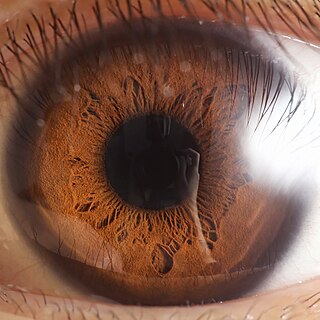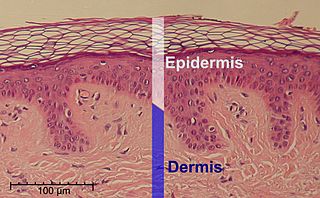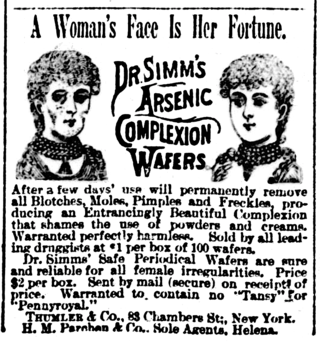
Complexion in humans is the natural color, texture, and appearance of the skin, especially on the face.

Complexion in humans is the natural color, texture, and appearance of the skin, especially on the face.
The word "complexion" is derived from the Late Latin complexi, which initially referred in general terms to a combination of things, and later in physiological terms, to the balance of humors.
The four humours were four fluids that were thought to permeate the body and influence its health. The concept was developed by ancient Greek thinkers around 400 BC and developed further by Galen. [1] People were thought to be either of the four temperaments: choleric, melancholic, phlegmatic, or sanguine.
During the Middle Ages in Europe, the Latin term complexio served as the translated form of the Greek word crasis, meaning temperament. [1] The term “temperament” referred to the balance of the qualities of hot, wet, cold, and dry; each human body carried a different mixture of the elements. [1] Thus, the Scythians, who lived in a cold climate, were considered colder and moister in complexion; the Aethiopians were hotter and drier. [1] Complexion was defined as “that quality which results from the mutual interaction and interpassion of the four contrary primary qualities residing within the elements. These elements are so minutely intermingled as each to lie in very intimate relationship to one another. Their opposite powers alternately conquer and become conquered until a quality is reached which is uniform throughout the whole: this is the complexion.” [2]
As Matthew Simon writes, “Since it served as a fundamental concept, not only in physiology but also in pathology and therapy, complexion theory provided important support for the idea that medicine constituted a unified and rational body of knowledge.” [1] By observation and judgment, medieval physicians determined the proper complexion of the individual when healthy. [3] The body was healthy when all was in balance, but diagnosis was difficult, as there was no absolute measure of the right complexion, since this varied for individuals. [3] Balance was thought to be restored by various remedies, which included bloodletting, scarifying, purging, and eating certain foods. [4]
Complexion was thought to be an indicator of one's character. The Spanish work known as Corbacho, written by Alfonso Martínez de Toledo (c. 1398—c. 1470), includes a chapter called "De las complexiones." In it he describes the personalities of men of varying complexions: "There are others who are melancholic: these men correspond to the Earth, which is the fourth element, which is cold and dry. These men are very angry, without a sense of tact or moderation... They have no sense of temperance in anything they do, and only bang their head against the wall. They're very iniquitous, petulant, miserable...” [5]
Complexion, in its original sense, engaged the attention of philosophers and musical theorists from ancient times right through to the Renaissance and beyond, in relation to the most favourable balancing of the 'qualities' or elements in order to heal and invigorate the soul: from Pythagoras and the musical theorist Aristoxenus, through Plato's dialogue Phaedo, Aristotle, Saint Augustine in his thesis on music, and Aquinas; and in the Florentine Renaissance, Marsilio Ficino in his work on the immortality of the soul, the Theologia Platonica.
Thus there are many references which filter through into Shakespeare's plays and sonnets derived from this body of thought; particularly in the description of important characters, and to the power of music above all to 'charm the savage breast', adjust the elements, and restore the equilibrium and balance, the 'harmony' of the soul: his characters call for music and are spellbound or restored by it, and in elevated mood, may hear it in the air, or sense its immortal harmonies everywhere.
Many surnames arose out of the existence of a complexion whose particularities may have differed from that of the village or town's population, and thus attracted enough notice to warrant a nickname. The Irish surname Rogan (from Ruadhán) referred to a person with red hair, or a ruddy complexion. The Scottish surname Bain (from bàn) referred to a fair-haired person, while Dunn (from donn) implies brown/dark hair, and Duff (from dubh) implies black hair. The English surname Brown, an extremely common surname in the English-speaking world, was originally applied to anyone with a slightly darker complexion, in the same manner that the surname White was applied to anyone with a particularly light complexion. The surname Gough is derived from the Welsh goch or coch, meaning "red" or "ruddy." King William II of England was called William Rufus ("the Red") because of his ruddy complexion. Ludovico il Moro ("the Moor") was called as such because of his swarthy complexion.
Puntarvolo: What complexion, or what stature bears he?
Gentleman: Of your stature, and very near upon your complexion.
Puntarvolo: Mine is melancholy.
Carlo Buffone: So is the dog's, just.
A person's complexion is a biological trait. The family of biological pigments known as melanin is mainly responsible for variation in tone. Melanocytes insert granules of melanin called melanosomes into the other skin cells of the human epidermis. The melanosomes in each recipient cell accumulate atop the cellular nucleus, where they protect the nuclear DNA from mutations caused by the sun's ionizing radiation. The human body tends to protect itself against harmful surroundings. The epidermis of the body, very sensitive and delicate, reacts almost immediately to most outside effects. By the time modern Homo sapiens evolved, all humans were dark-skinned. [7] [8] [9] [10] [11] [12] [13] People whose ancestors lived for long periods in the regions of the globe near the Equator generally have more active melanocytes, and therefore larger quantities of melanin in their skins. This makes their skins dark brown and protects them against high levels of exposure to the sun (it also depends on the country). Once some humans moved to areas of the globe closer to the poles, these people had far less need for protection from ionizing radiation, so their skin is usually lighter.
A study published in the Journal of Human Evolution proposes that people in the Tropics have developed dark skin to block out the sun and protect their body's folate reserves. Those living away from the equator have developed light skin to absorb enough sunlight to maintain adequate vitamin D in their bodies. [14]

Human skin color ranges from the darkest brown to the lightest hues. Differences in skin color among individuals is caused by variation in pigmentation, which is the result of genetics, exposure to the sun, disorders, or some combination thereof. Differences across populations evolved through natural selection or sexual selection, because of social norms and differences in environment, as well as regulations of the biochemical effects of ultraviolet radiation penetrating the skin.

Melanin consist of oligomers or polymers arranged in a disordered manner which among other functions provide the pigments of many organisms. Melanin pigments are produced in a specialized group of cells known as melanocytes. They have been described as "among the last remaining biological frontiers with the unknown".

Melanocytes are melanin-producing neural crest-derived cells located in the bottom layer of the skin's epidermis, the middle layer of the eye, the inner ear, vaginal epithelium, meninges, bones, and heart. Melanin is a dark pigment primarily responsible for skin color. Once synthesized, melanin is contained in special organelles called melanosomes which can be transported to nearby keratinocytes to induce pigmentation. Thus darker skin tones have more melanosomes present than lighter skin tones. Functionally, melanin serves as protection against UV radiation. Melanocytes also have a role in the immune system.

Freckles are clusters of concentrated melaninized cells which are most easily visible on people with a fair complexion. Freckles do not have an increased number of the melanin-producing cells, or melanocytes, but instead have melanocytes that overproduce melanin granules (melanosomes) changing the coloration of the outer skin cells (keratinocytes). As such, freckles are different from lentigines and moles, which are caused by accumulation of melanocytes in a small area. Freckles can appear on all types of skin tones. Of the six Fitzpatrick skin types, they are most common on skin tones 1 and 2, which usually belong to North Europeans. However, it can also be found on people all over the world. In England a historical term for freckles is summer-voys, sometimes spelt summervoise, which may be related to the German "summersprosse".

The integumentary system is the set of organs forming the outermost layer of an animal's body. It comprises the skin and its appendages, which act as a physical barrier between the external environment and the internal environment that it serves to protect and maintain the body of the animal. Mainly it is the body's outer skin.

The iris is a thin, annular structure in the eye in most mammals and birds, responsible for controlling the diameter and size of the pupil, and thus the amount of light reaching the retina. In optical terms, the pupil is the eye's aperture, while the iris is the diaphragm. Eye color is defined by the iris.

Chromatophores are cells that produce color, of which many types are pigment-containing cells, or groups of cells, found in a wide range of animals including amphibians, fish, reptiles, crustaceans and cephalopods. Mammals and birds, in contrast, have a class of cells called melanocytes for coloration.

Human hair color is the pigmentation of human hair follicles due to two types of melanin: eumelanin and pheomelanin. Generally, if more melanin is present, the color of the hair is darker; if less melanin is present, the hair is lighter. The tone of the hair is dependent on the ratio of black or brown eumelanin to yellow or red pheomelanin. Levels of melanin can vary over time causing a person's hair color to change, and it is possible to have hair follicles of more than one color on the same person. Some hair colors are associated with some ethnic groups due to observed higher frequency of particular hair color within their geographical region, e.g. straight dark hair amongst East Asians, Southeast Asians, Polynesians and Native Americans, a large variety of dark, fair, curly, straight, wavy and bushy hair amongst Europeans, West Asians and North Africans, curly, dark, and uniquely helical hair with Sub Saharan Africans, whilst gray, white or "silver" hair is often associated with age.

Keratinocytes are the primary type of cell found in the epidermis, the outermost layer of the skin. In humans, they constitute 90% of epidermal skin cells. Basal cells in the basal layer of the skin are sometimes referred to as basal keratinocytes. Keratinocytes form a barrier against environmental damage by heat, UV radiation, water loss, pathogenic bacteria, fungi, parasites, and viruses. A number of structural proteins, enzymes, lipids, and antimicrobial peptides contribute to maintain the important barrier function of the skin. Keratinocytes differentiate from epidermal stem cells in the lower part of the epidermis and migrate towards the surface, finally becoming corneocytes and eventually being shed, which happens every 40 to 56 days in humans.

The epidermis is the outermost of the three layers that comprise the skin, the inner layers being the dermis and hypodermis. The epidermis layer provides a barrier to infection from environmental pathogens and regulates the amount of water released from the body into the atmosphere through transepidermal water loss.

A melanosome is an organelle found in animal cells and is the site for synthesis, storage and transport of melanin, the most common light-absorbing pigment found in the animal kingdom. Melanosomes are responsible for color and photoprotection in animal cells and tissues.

Hyperpigmentation is the darkening of an area of skin or nails caused by increased melanin.

Skin whitening, also known as skin lightening and skin bleaching, is the practice of using chemical substances in an attempt to lighten the skin or provide an even skin color by reducing the melanin concentration in the skin. Several chemicals have been shown to be effective in skin whitening, while some have proven to be toxic or have questionable safety profiles. This includes mercury compounds which may cause neurological problems and kidney problems.

The human skin is the outer covering of the body and is the largest organ of the integumentary system. The skin has up to seven layers of ectodermal tissue guarding muscles, bones, ligaments and internal organs. Human skin is similar to most of the other mammals' skin, and it is very similar to pig skin. Though nearly all human skin is covered with hair follicles, it can appear hairless. There are two general types of skin, hairy and glabrous skin (hairless). The adjective cutaneous literally means "of the skin".

Light skin is a human skin color that has a low level of eumelanin pigmentation as an adaptation to environments of low UV radiation. Light skin is most commonly found amongst the native populations of Europe, West Asia, Central Asia, and Northeast Asia as measured through skin reflectance. People with light skin pigmentation are often referred to as "white" although these usages can be ambiguous in some countries where they are used to refer specifically to certain ethnic groups or populations.
Pigmentation disorders are disturbances of human skin color. There may be a loss or reduction, which may be related to loss of melanocytes or the inability of melanocytes to produce melanin or transport melanosomes correctly.

Ocular albinism type 1(OA1) is the most common type of ocular albinism, with a prevalence rate of 1:50,000. It is an inheritable classical Mendelian type X-linked recessive disorder wherein the retinal pigment epithelium lacks pigment while hair and skin appear normal. Since it is usually an X-linked disorder, it occurs mostly in males, while females are carriers unless they are homozygous. About 60 missense and nonsense mutations, insertions, and deletions have been identified in Oa1. Mutations in OA1 have been linked to defective glycosylation and thus improper intracellular transportation.

Amelanism is a pigmentation abnormality characterized by the lack of pigments called melanins, commonly associated with a genetic loss of tyrosinase function. Amelanism can affect fish, amphibians, reptiles, birds, and mammals including humans. The appearance of an amelanistic animal depends on the remaining non-melanin pigments. The opposite of amelanism is melanism, a higher percentage of melanin.

Iranian traditional medicine (ITM), also known as Persian traditional medicine, is one of the most ancient forms of traditional medicine.

Dark skin is a type of human skin color that is rich in melanin pigments. People with dark skin are often referred to as "black people", although this usage can be ambiguous in some countries where it is also used to specifically refer to different ethnic groups or populations.
{{cite web}}: CS1 maint: archived copy as title (link)![]() This article incorporates text from a publication now in the public domain : Chambers, Ephraim, ed. (1728). "Complexion". Cyclopædia, or an Universal Dictionary of Arts and Sciences (1st ed.). James and John Knapton, et al.
This article incorporates text from a publication now in the public domain : Chambers, Ephraim, ed. (1728). "Complexion". Cyclopædia, or an Universal Dictionary of Arts and Sciences (1st ed.). James and John Knapton, et al.